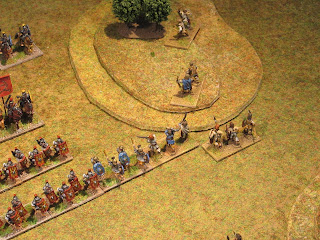In the third
test match of the series, Rome invaded the homeland of Dacia to find the Dacian
army arrayed across the valley floor with its flanks secured by a river to one side,
steep hills on the other.
Rome was
forced to reduce its normal frontage as the valley floor offered no more than
400 paces of open space.
The battle began
with the Dacian probing the Roman left from across the river with Rome
responding with a unit of equites to face the threat. The Dacian skirmishers no
longer a threat, Rome advanced its infantry forward with the artillery keeping
pace.
Once in range, the artillery had the desired effect of stinging the Dacian army into action launching its entire line forward to engage the Roman infantry to its front..
Holding its
ground on the left flank, the legion on the right, were able to cut through the
Dacian line.
Gaps in the
Dacian grew as the legion continued their blood spree forcing the Dacians to abandon
the field. A well-earned victory for Rome, 4 - 1.
Swapping deployment areas for game two left Rome in the same predicament as before with a contracted battle line; the legion in two lines, auxilia positioned on both flanks and all the mounted units in reserve in a third line.
Auxilia
infantry were moved to higher ground on the left, securing that flank as the
legion advanced on the enemy. Enemy troops at the other end of the valley floor
remained motionless but the heights to their right were filled with enemy activity,
improving their defensive position.
In a
surprise move, the entire Dacian right overran the Roman held hill, destroying
its defenders and causing alarm to the Roman commander.
Ceasing the
advance, Rome countered the threat to its left moving reserve cavalry and
legionnaires to restore order. Taking advantage of an immobilised Rome, the
remainder of the Dacian army joined the general melee. Pressed on two sides, Roman
casualties quickly mounted forcing its commander to withdraw from the field. Dacia
the victor, score 4 – 1.
Observations
The original plan to use the Sarmatian option did not materialise as cavalry played no role in the first battle.
In the
second battle, the four units making up the Dacian right, assumed at first a defensive
position on the perimeter of the hill. As the game progressed, a high pip score
for the Dacians was too nice a gift to let slide. This allowed the right wing
to overwhelm the Roman left and move the main army, including its general, to strike
the Roman line.
Could Rome
have won? In hindsight, interspersing the cavalry in the line would certainly have
allowed the placement of more auxilia to secure the hill.
Early
Imperial Roman
1 x General
(Cv), 1 x equites (Cv), 4 x legionnaires (4Bd), 3 x auxilia infantry (4Ax), 1 x
archers (Ps), 1 x light horse (LH), 1 x artillery (Art).
Dacian
1 x General (Cv), l x horsemen (Cv), 6 x warriors (3Wb), 2 x falxmen (3Wb), 2 x javelinmen (Ps), Second test, 1 x falxmen exchanged for Sarmatian (3Kn).









No comments:
Post a Comment